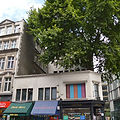Cheap
City of London


The Murder of Robert Pakington
At around 6am on Monday 13th November 1536, Robert Packington left his house in London’s Cheapside, to attend early Mass in the Mercers’ Chapel on the north side of West Cheap. His journey was a short one but, Packington carried a lantern, the night was dark and smoke from a thousand chimneys, mingling with a mist from the Thames, reduced visibility to a few paces. His route took him past the Great Conduit, a square building in the middle of Cheapside containing the fountain that provided the nearby houses with their water supply. As he crossed the street, just a few feet from his destination, a single shot rang out and he fell dead. Almost as soon as his body hit the floor, the crowd that rapidly gathered around him were asking questions. Why would someone want to kill one of London’s most respectable figures? Packington was not only a prominent merchant, and a leading light in the Worshipful Mercers’ Company, but also an MP. Why did no one notice the gunman or his weapon? The only firearms in general use at the time were matchlock arquebuses, that were more than a metre long and had to be held using both hands. The powder was ignited by means of a glowing match which would show up in the dark, and anybody carrying such a firearm would have attracted attention, yet this assassin, apparently, stood a matter of yards from a crowd, put the gun to his shoulder, and pulled the trigger., there was a flash and an explosion, and yet no one saw him. The reason that the murderer was able to melt into the darkness was, that he wasn’t using an arquebus at all, but the much smaller, more discreet wheellock pistol. In fact, poor Robert Packington probably holds the dubious distinction of being the first person in England to be killed with a handgun. The murderer was never found.

124-126 Cheapside
Cheapside was the centre of London retailing for centuries until the 19th century. In Medieval English, 'cheap' roughly translated as 'market, and the street was originally called Westcheap to differentiate it from nearby Eastcheap. Early food traders occupied booths in the middle of the street - at night traders often slept under their stalls. In 1274, butchers' and fishmongers' stalls were moved away (to Smithfield and Billingsgate respectively).
Traditionally, sellers of the same product were clustered on one street, a practice which is remembered in some of the street names running off Cheapside.
Through the middle ages, Cheapside was the Oxford Street of its day (and was much wider - it was narrowed during the 19th century), the city's retail centre, shopped by rich and poor. Nothing remains of the shops that once lined the street, apart from a lone 17th-century survival on the corner of Wood Street - 124-126 Cheapside.
Built in 1687 following the Great Fire, each shop has one room below, one room above. The building has been much altered and the shop fronts are 19th century and later, but this is a trace of what Cheapside once looked like.
The corner shop has shop front fittings dating from 1902, when the row was shortened during the widening of Wood Street. The shops' narrowness is due to the proximity of St Peter's Churchyard behind - on the site of St Peter Cheap, which burned down in the Great Fire. The tree behind the shops marks the site of the church and old records show that later leases on these shops forbid the addition of an extra storey or removal of the tree.
The tree achieved a measure of fame - Wordsworth mentioned it in a poem, The Reverie of Poor Susan. A verse from the poem is on a sign nearby.
Walter Thornbury in 1878 said the tree "has cheered many a weary businessman with memories of fresh green fields far away", and was nested by rooks in the 19th century until the birds decided the City was no longer a desirable residence.
Shopping shifted to the West End in the 19th century, meaning Cheapside lost its retail prestige and became a street of offices. However, the opening of shopping centre One New Change has at least put it back on the retail map, and it's apt that One New Change sits directly opposite the street's only retail relics.
Coordinates: 51°30'51.72"N 0°05'41.32"W


